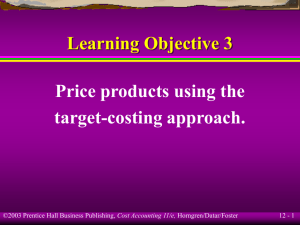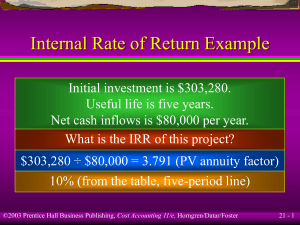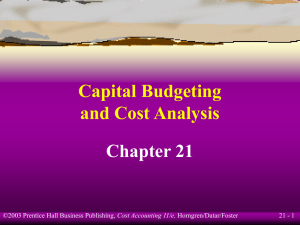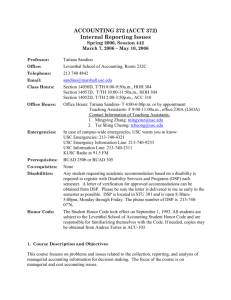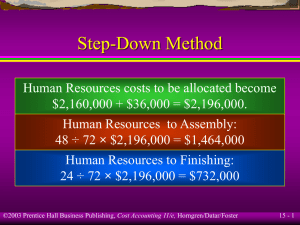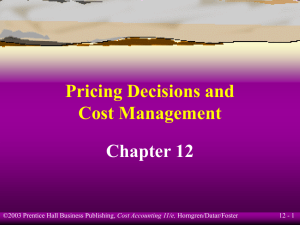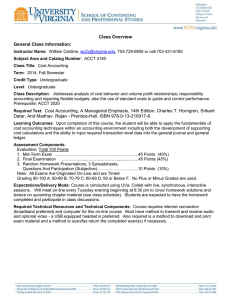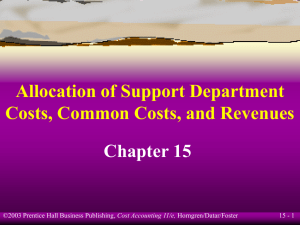Capital Budgeting and Cost Analysis Chapter 21 21 - 1
advertisement
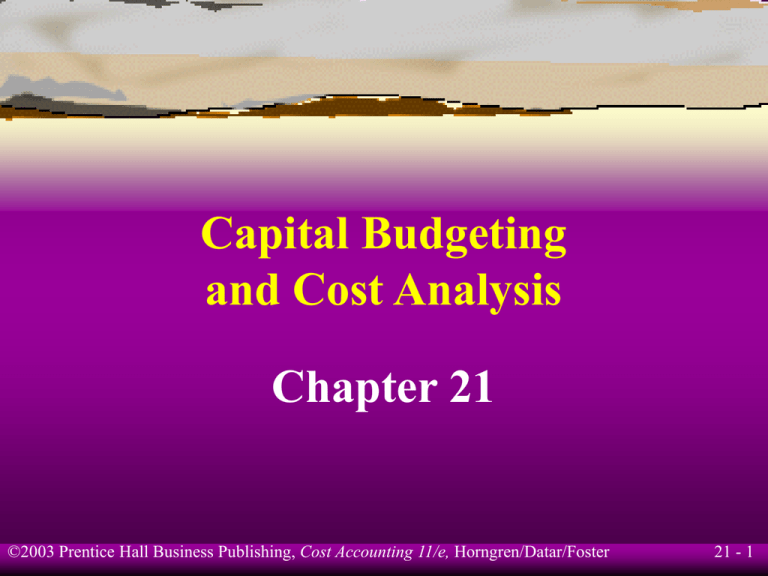
Capital Budgeting and Cost Analysis Chapter 21 ©2003 Prentice Hall Business Publishing, Cost Accounting 11/e, Horngren/Datar/Foster 21 - 1 Learning Objective 1 Recognize the multiyear focus of capital budgeting. ©2003 Prentice Hall Business Publishing, Cost Accounting 11/e, Horngren/Datar/Foster 21 - 2 Two Dimensions of Cost Analysis 1. A project dimension 2. An accounting-period dimension The accounting system that corresponds to the project dimension is termed life-cycle costing. ©2003 Prentice Hall Business Publishing, Cost Accounting 11/e, Horngren/Datar/Foster 21 - 3 Two Dimensions of Cost Analysis Project D Project C Project B Project A 2002 2003 2004 2005 ©2003 Prentice Hall Business Publishing, Cost Accounting 11/e, Horngren/Datar/Foster 2006 21 - 4 Learning Objective 2 Understand the six stages of capital budgeting for a project. ©2003 Prentice Hall Business Publishing, Cost Accounting 11/e, Horngren/Datar/Foster 21 - 5 Capital Budgeting Capital budgeting is the making of long-run planning decisions for investments in projects and programs. It is a decision-making and control tool that focuses primarily on projects or programs that span multiple years. ©2003 Prentice Hall Business Publishing, Cost Accounting 11/e, Horngren/Datar/Foster 21 - 6 Capital Budgeting Capital budgeting is a six-stage process: 1. Identification stage 2. Search stage 3. Information-acquisition stage 4. Selection stage 5. Financing stage 6. Implementation and control stage ©2003 Prentice Hall Business Publishing, Cost Accounting 11/e, Horngren/Datar/Foster 21 - 7 Capital Budgeting Example One of the goals of Assisted Living is to improve the diagnostic capabilities of its facility. Management identifies a need to consider the purchase of new equipment. The search stage yields several alternative models, but management focuses on one particular machine. ©2003 Prentice Hall Business Publishing, Cost Accounting 11/e, Horngren/Datar/Foster 21 - 8 Capital Budgeting Example The administration acquires information. Initial investment is $245,000. Investment in working capital is $5,000. Useful life is three years. Estimated residual value is zero. Net cash savings is $125,000, $130,000, and $110,000 over its life. ©2003 Prentice Hall Business Publishing, Cost Accounting 11/e, Horngren/Datar/Foster 21 - 9 Capital Budgeting Example Working capital is expected to be recovered at the end of year 3 with an expected return of 10%. Operating cash flows are assumed to occur at the end of the year. In the selection stage, management must decide whether to purchase the new machine. ©2003 Prentice Hall Business Publishing, Cost Accounting 11/e, Horngren/Datar/Foster 21 - 10 Learning Objective 3 Use and evaluate the two main discounted cash-flow (DCF) methods: the net present value (NPV) method and the internal rate-of-return (IRR) method. ©2003 Prentice Hall Business Publishing, Cost Accounting 11/e, Horngren/Datar/Foster 21 - 11 Time Value of Money Compound Growth, 5 periods at 6% Year 5: $1.338 Year 4: $1.262 Year 3: $1.91 Year 2: $1.124 Year 1: $1.06 Year 0: $1.00 ©2003 Prentice Hall Business Publishing, Cost Accounting 11/e, Horngren/Datar/Foster 21 - 12 Discounted Cash Flow There are two main DCF methods: Net present value (NPV) method Internal rate-of-return (IRR) method ©2003 Prentice Hall Business Publishing, Cost Accounting 11/e, Horngren/Datar/Foster 21 - 13 Net Present Value Example Only projects with a zero or positive net present value are acceptable. What is the the net present value of the diagnostic machine? ©2003 Prentice Hall Business Publishing, Cost Accounting 11/e, Horngren/Datar/Foster 21 - 14 Net Present Value Example Year in the Life of the Project 0 1 2 3 $(250,000) $125,000 $130,000 $115,000 Net initial investment Annual cash inflows ©2003 Prentice Hall Business Publishing, Cost Accounting 11/e, Horngren/Datar/Foster 21 - 15 Net Present Value Example Net Cash Year 10% Col. Inflows 1 0.909 $125,000 2 0.826 130,000 3 0.751 115,000 Total PV of net cash inflows Net initial investment Net present value of project NPV of Net Cash Inflows $113,625 107,380 86,365 $307,370 250,000 $ 57,370 ©2003 Prentice Hall Business Publishing, Cost Accounting 11/e, Horngren/Datar/Foster 21 - 16 Net Present Value Example The company is considering another investment. Initial investment is $245,000. Investment in working capital is $5,000. Working capital will be recovered. Useful life is three years. Estimated residual value is $4,000. Net cash savings is $80,000 per year. Expected return is 10%. ©2003 Prentice Hall Business Publishing, Cost Accounting 11/e, Horngren/Datar/Foster 21 - 17 Net Present Value Example Net Cash Years 10% Col. Inflows 1-3 2.487 $80,000 3 0.751 9,000 Total PV of net cash inflows Net initial investment Net present value of project NPV of Net Cash Inflows $198,960 6,759 $205,719 250,000 ($ 44,281) ©2003 Prentice Hall Business Publishing, Cost Accounting 11/e, Horngren/Datar/Foster 21 - 18 Internal Rate of Return Investment = Expected annual net cash inflow × PV annuity factor Investment ÷ Expected annual net cash inflow = PV annuity factor ©2003 Prentice Hall Business Publishing, Cost Accounting 11/e, Horngren/Datar/Foster 21 - 19 Internal Rate of Return Example Initial investment is $303,280. Useful life is five years. Net cash inflows is $80,000 per year. What is the IRR of this project? $303,280 ÷ $80,000 = 3.791 (PV annuity factor) 10% (from the table, five-period line) ©2003 Prentice Hall Business Publishing, Cost Accounting 11/e, Horngren/Datar/Foster 21 - 20 Comparison of NPV and IRR The NPV method has the advantage that the end result of the computations is expressed in dollars and not in a percentage. Individual projects can be added. It can be used in situations where the required rate of return varies over the life of the project. ©2003 Prentice Hall Business Publishing, Cost Accounting 11/e, Horngren/Datar/Foster 21 - 21 Comparison of NPV and IRR The IRR of individual projects cannot be added or averaged to derive the IRR of a combination of projects. ©2003 Prentice Hall Business Publishing, Cost Accounting 11/e, Horngren/Datar/Foster 21 - 22 Learning Objective 4 Use and evaluate the payback method. ©2003 Prentice Hall Business Publishing, Cost Accounting 11/e, Horngren/Datar/Foster 21 - 23 Payback Method Payback measures the time it will take to recoup, in the form of expected future cash flows, the initial investment in a project. ©2003 Prentice Hall Business Publishing, Cost Accounting 11/e, Horngren/Datar/Foster 21 - 24 Payback Method Example Assisted Living is considering buying Machine 1. Initial investment is $210,000. Useful life is eleven years. Estimated residual value is zero. Net cash inflows is $35,000 per year. ©2003 Prentice Hall Business Publishing, Cost Accounting 11/e, Horngren/Datar/Foster 21 - 25 Payback Method Example How long would it take to recover the investment? $210,000 ÷ $35,000 = 6 years Six years is the payback period. ©2003 Prentice Hall Business Publishing, Cost Accounting 11/e, Horngren/Datar/Foster 21 - 26 Payback Method Example Suppose that as an alternative to the $210,000 piece of equipment, there is another one (Machine 2) that also costs $210,000 but will save $42,000 per year during its five-year life. What is the payback period? $210,000 ÷ $42,000 = 5 years Which piece of equipment is preferable? ©2003 Prentice Hall Business Publishing, Cost Accounting 11/e, Horngren/Datar/Foster 21 - 27 Payback Method Example Assisted Living is considering buying Machine 3. Initial investment is $250,000. Useful life is eleven years. Cash savings are $160,000, $180,000, and $110,000 over its life. What is the payback period? ©2003 Prentice Hall Business Publishing, Cost Accounting 11/e, Horngren/Datar/Foster 21 - 28 Payback Method Example Year 1 brings in $160,000. Recovery of the amount invested occurs in Year 2. ©2003 Prentice Hall Business Publishing, Cost Accounting 11/e, Horngren/Datar/Foster 21 - 29 Payback Method Example Payback = 1 year + $ 90,000 needed to complete recovery ÷ 180,000 net cash inflow in Year 2 1 year + 0.5 year = = 1.5 years or 1 year and 6 months ©2003 Prentice Hall Business Publishing, Cost Accounting 11/e, Horngren/Datar/Foster 21 - 30 Learning Objective 5 Use and evaluate the accrual accounting rate-of-return (AARR) method. ©2003 Prentice Hall Business Publishing, Cost Accounting 11/e, Horngren/Datar/Foster 21 - 31 Accrual Accounting Rate-of-Return Method The accrual accounting rate-of-return (AARR) method divides an accounting measure of income by an accounting measure of investment. Increase in expected Initial AARR = average annual ÷ required operating income investment ©2003 Prentice Hall Business Publishing, Cost Accounting 11/e, Horngren/Datar/Foster 21 - 32 Accrual Accounting Rate-of-Return Method Example Initial investment is $303,280. Useful life is five years. Net cash inflows is $80,000 per year. IRR is 10%. What is the average operating income? ©2003 Prentice Hall Business Publishing, Cost Accounting 11/e, Horngren/Datar/Foster 21 - 33 Accrual Accounting Rate-of-Return Method Example Straight-line depreciation is $60,656 per year. Average operating income is $80,000 – $60,656 = $19,344. What is the AARR? AARR = ($80,000 – $60,656) ÷ $303,280 = .638, or 6.4% ©2003 Prentice Hall Business Publishing, Cost Accounting 11/e, Horngren/Datar/Foster 21 - 34 Learning Objective 6 Identify and reduce conflicts from using DCF for capital budgeting decisions and accrual accounting for performance evaluation. ©2003 Prentice Hall Business Publishing, Cost Accounting 11/e, Horngren/Datar/Foster 21 - 35 Performance Evaluation A manager who uses DCF methods to make capital budgeting decisions can face goal congruence problems if AARR is used for performance evaluation. Suppose top management uses the AARR to judge performance if the minimum desired rate of return is 10%. A machine with an AARR of 6.4% will be rejected. ©2003 Prentice Hall Business Publishing, Cost Accounting 11/e, Horngren/Datar/Foster 21 - 36 Performance Evaluation The conflict between using AARR and DCF methods to evaluate performance can be reduced by evaluating managers on a project-by-project basis. ©2003 Prentice Hall Business Publishing, Cost Accounting 11/e, Horngren/Datar/Foster 21 - 37 End of Chapter 21 ©2003 Prentice Hall Business Publishing, Cost Accounting 11/e, Horngren/Datar/Foster 21 - 38
